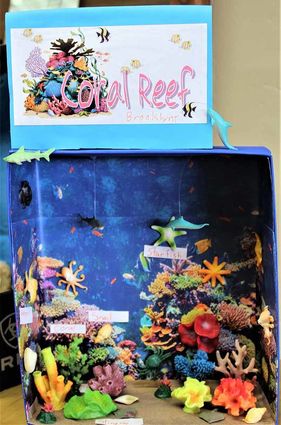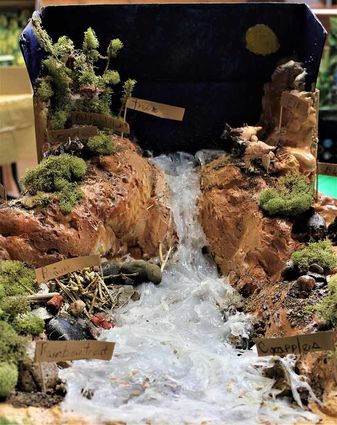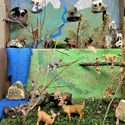Meadowlark Elementary Third Grade Biomes invade First Bank in Chinook
March 28, 2018

This biome, of a coral reef, used real coral to simulate the bottom of the ocean. The biome seems to accurately show what kinds of fish and creatures thrive at different levels of an ocean. Later in the spring the 30 biomes will be displayed at the Blaine County Wildlife Museum.
Readers who have had a third grader at Meadowlark Elementary in the last several years are likely familiar with the term biome. In fact, they've probably helped at least one of their students create a miniature, table top exhibit of a "community of flora and fauna occupying a major habitat." About 30 carefully researched biomes, many made totally with materials at hand, are proudly displayed in the lobby of the bank in Chinook.
Third grade teacher Mrs. Bobbi Weinheimer and her colleague, Mrs. Bridget Metcalfe, gave the criteria for making biomes to students, then turned the scholars loose. Weinheimer said, "Both Mrs. Metcalfe and I wanted a project that would get students and their parents, even siblings, involved working to create something together." Weinheimer said she's assigned this project for several years in the belief that "we don't get parents and students involved enough. Both parents and kids are too busy with their own pursuits nowadays."
The biome project
Before families begin building the model they have to research the types of animals and plants that would be found in a particular environment. The setting for the most recent biomes included: tundra; desert; grassland; rain forest; coral reef; freshwater; arctic; ocean, mountain/alpine and forest. The idea is to identify animals and plants that would exist together in a natural setting.
The teachers encourage students to "use things that are at hand, not that they necessarily have to buy." In the completed biomes one can see rocks, sticks, plants, dirt, sand and anything else readily available outside or around the house. Creative uses of running shoe boxes and other cardboard containers are impressive. Most students resorted to purchased animals and worked them into the natural setting the third graders and families had created.

In this biome of a mountain, a waterfall and river were made with what appears to be silicone. Biomes made by Meadowlark third graders, per teachers' directions, were to be researched and built with help from parents and siblings, one of the few times a family might be encouraged to get directly involved in helping with 'homework.
There were some particularly clever uses of materials in the biomes. In a mountain biome, with evergreens and rocks, a water fall and resulting river was made from what appeared to be silicone. It really looked like water. An arctic biome had penguins and polar bears on what appeared to be ice flows, but was Styrofoam. It was a very realistic effect. Jessica Aberg, a First Bank loan officer, stepped out of her office to show me a grassland biome made by her third grader, Amalie. Mom beamed as she talked about the process of making the display.
Check out the biomes at First Bank and later at the Wildlife Museum
First Bank Branch Manager Craig Lowham said he was delighted the kids were showcasing their works at the bank. He added, "It's always fun to have school projects on display in our bank." Mrs. Weinheimer said the biomes would be on display for a couple of weeks at First Bank, then be taken to the Blaine County Wildlife Museum for additional viewing. Students will take their biomes home at the end of school.
Take a few minutes to see how this generation views the natural world. The presentations of the biomes vary from "the simple to the sublime." And, likely, some parents are proud of the fruits of their and their children's labors. Congratulations to all the third graders at Meadowlark for their creative work.










